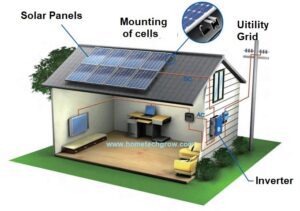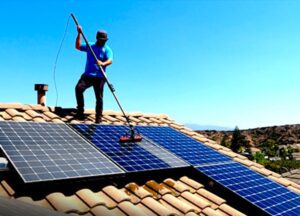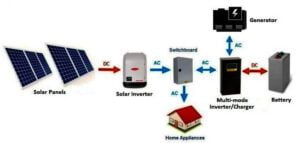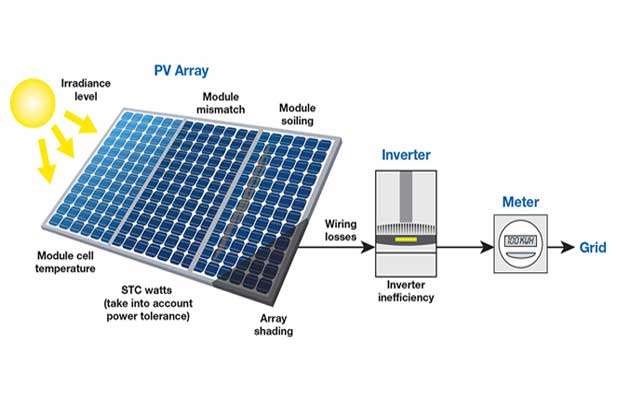What is a Photovoltaic (PV) cell?
- Photovoltaic (PV) cells is used to convert sunlight into electricity through a process called the photovoltaic effect. Here is how it works:
-
- Photons from the sun hit the PV cell and are absorbed by the semiconductor material, usually made of silicon.
- The absorbed photons create an electric field, freeing electrons from their atoms.
- The free electrons flow through the material, creating a flow of electric current.
- Metal contacts on the top and bottom of the cell collect the current and direct it to flow out of the cell.
- The electricity generated by the PV cell can be used immediately, stored in a battery, or sent to the electrical grid.
- It is important to note that the efficiency of a PV cell is influenced by several factors, including the material used, the size and shape of the cell, and the temperature at which it is operating
- By connecting multiple PV cells together in a photovoltaic panel or array, it is possible to generate sufficient electricity to power homes, businesses, and even entire communities.

- Inside the photovoltaic cells


How to use solar cells for electricity generation?
- To use a solar cell for electricity generation, you need to follow these steps:
-
- Set up the solar panel: Mount the solar panel in a location that receives direct sunlight for the maximum number of hours in a day. Make sure the panel is securely fastened and tilted at an angle that allows it to receive maximum sunlight.
- Connect the panel to an inverter: An inverter is a device that converts the direct current (DC) electricity generated by the solar panel into alternating current (AC) electricity, which is the form of electricity used in homes and businesses.
- Store excess electricity: If you generate more electricity than you need, you can store the excess in a battery for later use. This is especially important for off-grid systems where you do not have access to the electrical grid.
- Use the electricity: The electricity generated by the solar panel can be used to power your home or business, either directly or by being fed into the electrical grid.
- It is important to note that the amount of electricity generated by a solar panel will depend on several factors, including the size of the panel, the location, and the weather conditions
- To ensure that you have enough electricity to meet your needs, it may be necessary to install multiple panels or connect to the electrical grid
- Additionally, regular maintenance of the solar panel, including cleaning the surface to remove dirt and debris, is important to ensure that it continues to operate efficiently.

Cleaning of Solar Panels for Better Efficiency
- To maintain the productivity, efficiency, and effectiveness of the panels, you should clean all the solar panels every 6 months to a year
- The amount of dirt deposition on panels depends on where you live and the level of dirt and pollution, the need for cleaning may be more frequent
- Cleaning solar panels is an important task to ensure that they are functioning at their highest efficiency. Dirt, dust, and grime can build up on the surface of the panels and reduce the amount of light that can penetrate through the cells, leading to a decrease in the overall energy output. Here are some steps you can follow to clean your solar panels:
- Safe Cleaning:
- When cleaning solar panels, it’s important to prioritize safety
- Always use a sturdy ladder and wear rubber-soled shoes for stability
- If the panels are located on a roof, make sure the roof is safe to walk on and consider using a safety harness
- Determine the type of dirt:
- Before cleaning, determine the type of dirt on the panels
- Dry dirt can be removed with a soft-bristled brush or a microfiber cloth, while sticky substances may require the use of a cleaning solution
- Choose the right cleaning solution:
- Use a solution that is specifically designed for cleaning solar panels
- Avoid using household cleaning products, as they can damage the panels and leave streaks
- Clean Properly:
- Start by brushing off any loose dirt and debris with a soft-bristled brush or microfiber cloth
- Then, apply the cleaning solution to a cloth and gently wipe down the surface of the panels, making sure to get into the corners and crevices
- Rinse the panels thoroughly with water to remove any residue from the cleaning solution
- Check all the panels:
- After cleaning, inspect the panels for any damage or cracks
- If you notice any issues, have them professionally repaired to ensure continued performance
- Safe Cleaning:

- All parts of the solar panel must be cleaned

- You should clean solar panels at least twice a year, or more frequently if they are located in areas with high levels of dust or pollution
- Regular cleaning will ensure proper functioning with the highest efficiency
How many photovoltaic cells are needed to power a house?
- The number of solar panels that a home needs varies between 4 and 18 photovoltaic panel modules
- To entirely offset average annual electricity consumption, the number of cells varies from home to home
- The average household may need around 17 panels of 400-Watt solar panels
- 14 solar panels that each have a power rating of 350 watts will give you a 5 kW array
- The goal for any solar project should be 100% electricity offset and maximum savings


- The number of solar cells needed to power a house depends on several factors, including the size of the home, the location, and the local climate
- A rough estimate is that it takes about 10 to 12 solar panels to generate enough electricity to power an average-sized home in the United States. You may need at least 5 panels to run a normal family.
- However, this is just a rough estimate and the actual number of panels needed can vary greatly depending on the specific requirements of the home and its electrical usage
- Furthermore, it’s important to note that solar panels can not provide 100% of a home’s electricity requirements
- In most cases, homes will still be connected to the grid and will receive electricity from the utility company when the solar panels are not generating enough energy
- This is known as grid-tied” solar, and it allows homeowners to take advantage of net metering, which allows them to earn credits for any excess electricity they generate.
Benefits of Installing Solar Cells in Your Home
- The use of renewable energy sources has become increasingly popular in recent years and for good reason
- Not only is it better for the environment, but it can also save you money in the long run. One of the most popular forms of renewable energy is solar energy
- Solar cells, also known as photovoltaic (PV) cells, convert the energy from the sun into electricity that can be used to power your home
Lower Energy Bills
- One of the most obvious benefits of solar cells is that they can help reduce your monthly energy bills
- Solar cells provide a source of clean, renewable energy that can replace the need for traditional sources of energy such as coal, natural gas, and oil
- By producing your own electricity, you can significantly reduce your reliance on the electrical grid, which means lower energy bills.
Increased Home Value
- Installing solar cells in your home can also increase their value
- In recent years, solar energy has become more popular, and many potential home buyers are looking for homes with solar panels
- By installing solar cells, you can increase the value of your home and make it more attractive to potential buyers.
Good for the Environment
- Solar energy is a clean and renewable source of energy, which means it doesn’t produce any harmful emissions or contribute to climate change
- By using solar cells, you can help reduce your carbon footprint and do your part in preserving the environment.
Low Maintenance Costs
- Once installed, solar cells require very little maintenance
- They are designed to be durable and can last for several decades, so you won’t have to worry about constantly replacing them
- In addition, they don’t have any moving parts, which means they are less likely to break down and require repairs.
Government Subsidy and Tax Incentives
- Many governments provide subsidies for the installation as mentioned in the post
- In many areas, there are tax incentives available for homeowners who install solar cells
- These incentives can help offset the cost of installation and make it more affordable
- It’s important to check with your local government to see what incentives are available in your area.
Components of Solar Panel
- Solar PV cell System consists of 4 main components that decide the working of a solar energy system.
- Solar Panel
- Solar Inverter
- Solar Battery
- Panel Stand, and
- Solar Panel Installation Accessories
- Solar Energy Systems are of different types and can be used as per your needs and location. The 2 types of Solar Energy System are:
- Solar Panel with Battery (Off Grid Solar System)
- Solar Panel without Battery (On Grid Solar System)
- A Solar inverter is the main component of both systems. While we install a solar energy system, we generally buy the following products

How much does Solar Panel Installation Cost?
Monocrystalline solar panels
- The average cost for an energy-efficient option, monocrystalline solar panels
- The average cost per unit watt: Rs. 43 to Rs. 65 per watt (USD 0.5 )
- For a 3kW solar panel system, the costs for a grid-connected solar system vary from Rs. 2,00,000 to Rs. 3,00,000
- For a standalone solar system: Rs. 2,50,000 to 3,50,000
Polycrystalline Solar Panels
- The average cost for Less energy-efficient than monocrystalline solar panels is Rs. 30 to Rs. 36 per watt,
- For a 5kW solar panel system, the cost is around 3,00,000 which may an affordable option.
Importance of Solar Panel 120% Rule
- For designing a solar PV system for any residential or commercial building this rule is important as per National Electrical Code (NEC)
- Otherwise, your setup will be at risk for a higher current. The electric panel can receive more energy beyond its capacity (>100%). It will be exposing life and property to fire risks. Hence you need to observe the system capacity and follow the NEC code.
- The solar panel 120% rule is used to determine the limit energy storage for a building or structure can hold the site’s service can handle
- Building structures such as roofs, ground, or carports will support several kilowatts of PV. This is where you may note the 120% rule.
- As per the 120% rule, solar PV systems should be installed in electrical boxes up to 120% of the busbar’s label rating.
- For example: if your home’s electrical meter rating is 200 amps, the rule allows an additional 20%, an equivalent of 40 amps from the solar system.
200*120 = 240 amps
240-200= 40 amp
- At the center of the MSP installation, a busbar is made of metal components that can melt on overloading a potential fire hazard
- In addition to it, a circuit breaker trips when power exceeds the rated capacity

Summary
- In conclusion, installing solar cells in your home is a smart investment
- Not only will it save you money on energy bills, but it will also increase the value of your home, be better for the environment, and require very little maintenance. So if you’re looking for a way to save money and do your part for the environment, consider going solar today!
